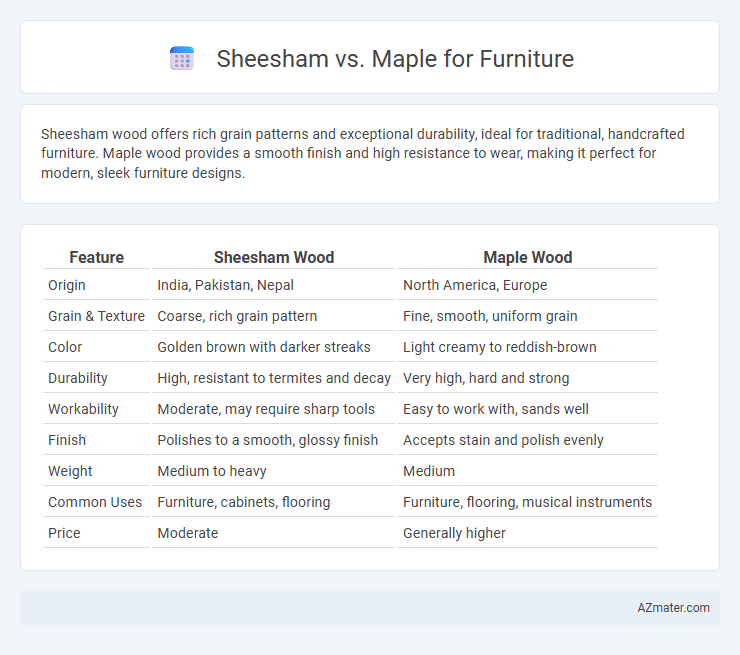Sheesham wood offers rich grain patterns and exceptional durability, ideal for traditional, handcrafted furniture. Maple wood provides a smooth finish and high resistance to wear, making it perfect for modern, sleek furniture designs.
Table of Comparison
| Feature | Sheesham Wood | Maple Wood |
|---|---|---|
| Origin | India, Pakistan, Nepal | North America, Europe |
| Grain & Texture | Coarse, rich grain pattern | Fine, smooth, uniform grain |
| Color | Golden brown with darker streaks | Light creamy to reddish-brown |
| Durability | High, resistant to termites and decay | Very high, hard and strong |
| Workability | Moderate, may require sharp tools | Easy to work with, sands well |
| Finish | Polishes to a smooth, glossy finish | Accepts stain and polish evenly |
| Weight | Medium to heavy | Medium |
| Common Uses | Furniture, cabinets, flooring | Furniture, flooring, musical instruments |
| Price | Moderate | Generally higher |
Introduction to Sheesham and Maple Wood
Sheesham wood, also known as Indian Rosewood, is renowned for its rich grain patterns, durability, and natural resistance to decay, making it a popular choice for high-quality furniture. Maple wood, characterized by its light color and fine, uniform grain, offers excellent hardness and smooth finishing, ideal for furniture that requires a sleek and modern appearance. Both woods provide unique aesthetic and strength properties, with Sheesham leaning towards a classic, warm look and Maple favoring a contemporary, clean finish.
Sheesham vs Maple: Origin and Availability
Sheesham, also known as Indian Rosewood, originates primarily from the Indian subcontinent and is widely available in South Asia and parts of the Middle East. Maple, native to North America and Europe, has a broader commercial distribution globally due to extensive cultivation and harvesting. The availability of Sheesham tends to be more region-specific, while Maple is more commonly accessible for furniture manufacturing worldwide.
Appearance and Grain Patterns Compared
Sheesham wood features rich, dark brown hues with striking golden streaks, showcasing a unique and varied grain pattern that adds depth and warmth to furniture pieces. In contrast, maple offers a lighter, creamy appearance with a consistent and fine grain, known for its smooth texture and subtle, wavy patterns. This difference in coloration and grain complexity makes Sheesham ideal for bold, traditional designs, while maple suits contemporary furniture styles emphasizing clean, uniform surfaces.
Durability and Hardness Differences
Sheesham wood, also known as Indian rosewood, exhibits higher durability and hardness compared to maple, making it ideal for heavy-use furniture. With a Janka hardness rating of approximately 2,440 lbf, Sheesham withstands dents and scratches better than maple, which has a Janka rating of around 1,450 lbf. The natural oils in Sheesham contribute to its resistance against moisture and decay, enhancing its longevity in diverse environments.
Workability and Crafting Ease
Sheesham wood offers excellent workability with its fine grain and natural oils that reduce splintering, making it easier to carve and finish compared to Maple. Maple is harder and denser, requiring sharper tools and more effort during crafting, though it provides a smooth surface ideal for detailed work and staining. Both woods are favored in furniture making, but Sheesham's balance of durability and ease of carving often appeals more to artisans focusing on intricate designs.
Cost Comparison: Sheesham vs Maple
Sheesham wood typically costs more than maple due to its durability, rich grain patterns, and limited availability, making it a premium choice for high-quality furniture. Maple is generally more affordable, widely available, and offers a smooth, consistent grain, which appeals to budget-conscious consumers seeking sturdy furniture. The cost difference often influences buyers to select maple for economical options while reserving Sheesham for investment pieces emphasizing longevity and aesthetic appeal.
Maintenance and Longevity
Sheesham wood offers high durability and natural resistance to termites and rot, requiring minimal maintenance such as occasional polishing to preserve its rich grain and color. Maple furniture is known for its smooth surface and strength but demands more regular upkeep, including cleaning and refinishing to prevent surface scratches and wear over time. While Sheesham typically lasts longer due to its dense hardwood properties, Maple provides a sleek finish but may need more frequent care to maintain its appearance and structural integrity.
Sustainability and Environmental Impact
Sheesham wood, sourced from Dalbergia trees, is renowned for its durability and natural oils that resist pests, often harvested from sustainably managed forests promoting reforestation. Maple, primarily derived from North American hardwood forests, offers a fast-growing alternative with lower deforestation risks, benefiting from certification programs like FSC to ensure responsible sourcing. Both woods impact the environment differently; Sheesham's slower growth requires careful management to prevent overharvesting, while Maple's quicker regeneration supports sustainable furniture production with reduced carbon footprints.
Best Furniture Types for Sheesham and Maple
Sheesham wood, known for its rich grain and durability, is ideal for crafting high-end furniture such as carved cabinets, ornate dining tables, and sturdy bed frames due to its natural resistance to termites and moisture. Maple wood, recognized for its smooth finish and light color, excels in making modern furniture pieces like sleek dressers, functional kitchen cabinets, and durable office desks because of its strength and ease of polishing. Both woods offer unique advantages, with Sheesham best suited for luxurious, detailed designs and Maple optimal for contemporary, minimalist furniture styles.
Sheesham or Maple: Which Should You Choose?
Sheesham wood is renowned for its durability, rich grain patterns, and natural resistance to termites, making it ideal for high-quality, long-lasting furniture. Maple offers a smooth texture, light hue, and excellent strength, suited for minimalist and modern designs. Choose Sheesham for traditional, robust pieces and Maple for sleek, contemporary furniture with a clean finish.

Infographic: Sheesham vs Maple for Furniture
 azmater.com
azmater.com